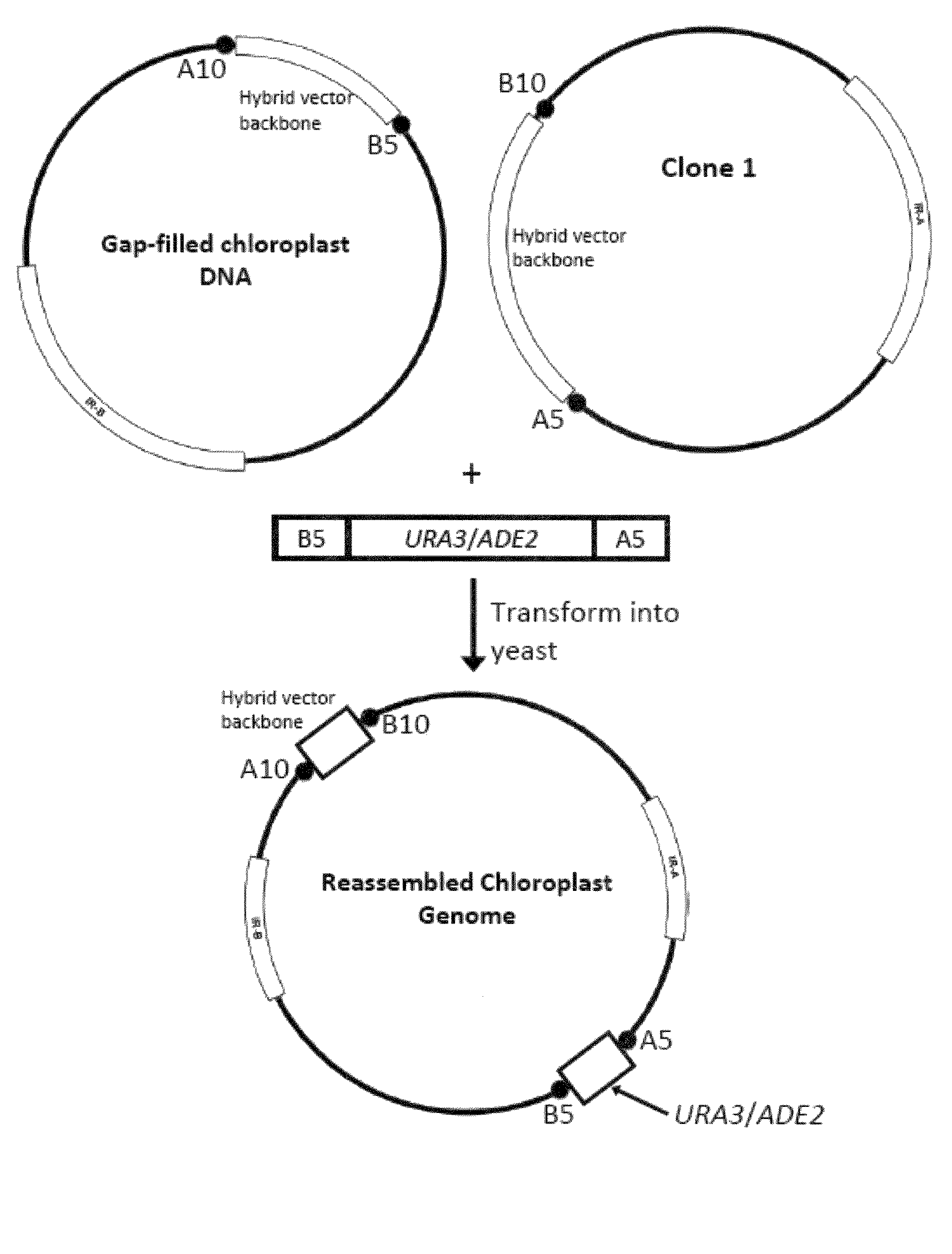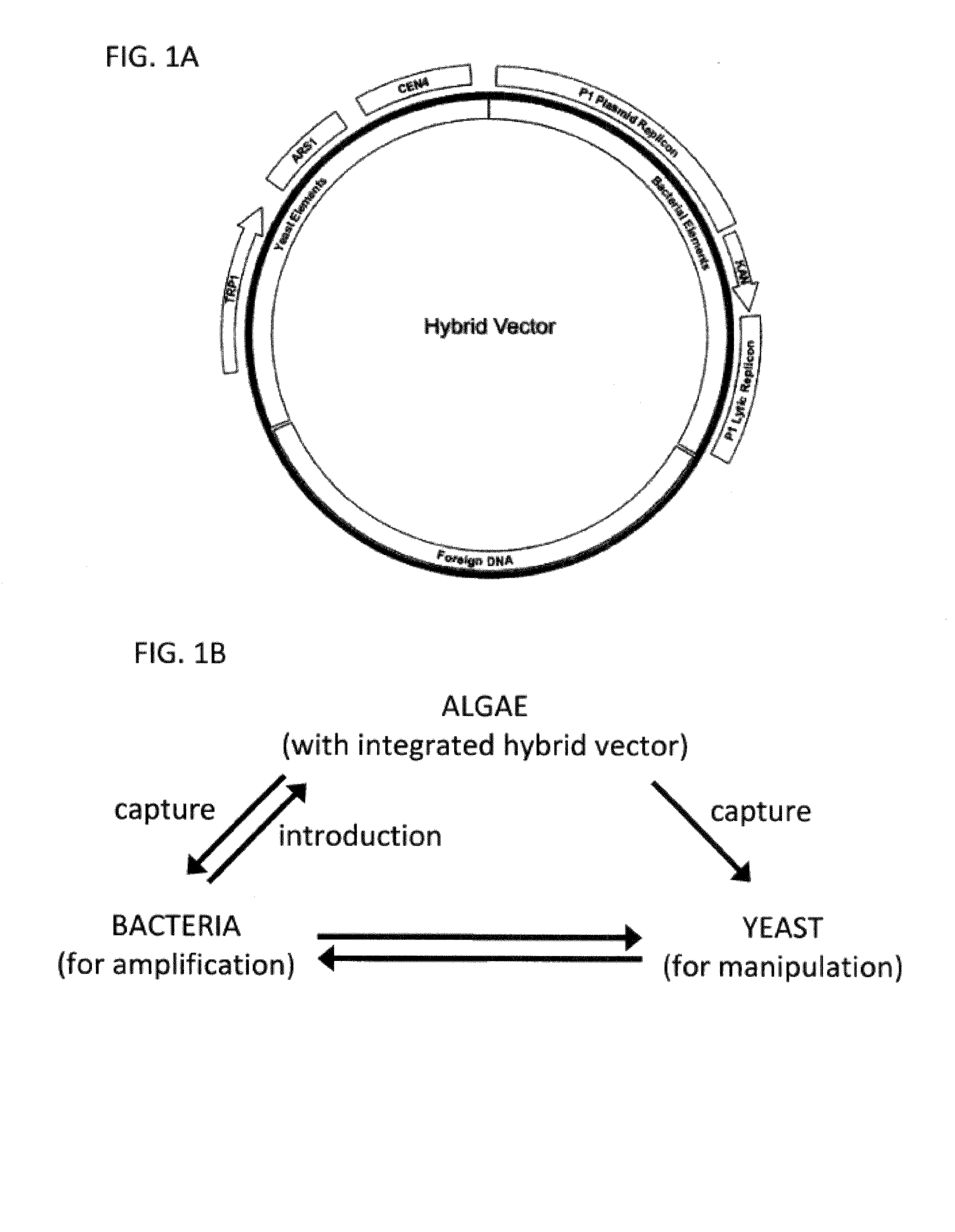System for capturing and modifying large pieces of genomic DNA and constructing organisms with synthetic chloroplasts
a technology of genomic dna and genome, which is applied in the field of system for capturing and modifying large pieces of genomic dna and constructing organisms with synthetic chloroplasts, can solve the problems of cumbersome isolating sufficient quantities of yac dna from agarose gel for microinjection or electroporation, and the inability to fully absorb agarose gel, so as to increase the production of a product naturally and increase the production of a produ
- Summary
- Abstract
- Description
- Claims
- Application Information
AI Technical Summary
Benefits of technology
Problems solved by technology
Method used
Image
Examples
example 1
DNA Purification and Analysis
[0141]DNA is isolated and analyzed according to methods known in the art.
[0142]To prepare DNA from Chlamydomonas reinhardtii to use as a template for PCR, 106 algae cells (from agar plate or liquid culture) are suspended in 10 mnM EDTA and heated to 95° C. for 10 minutes, then cooled to near 23° C. The solution is added to the PCR mixture directly.
[0143]To prepare purified chloroplast DNA from Chlamydomonas reinhardtii, 5×108 algae cells are collected from liquid culture by centrifagation at 3000×g for 10 min, washed once with water, centrifuged at 3000×g for 10 min, resuspended in 10 mL of lysis solution (10 mM Tris pH=8.0, 10 mM EDTA, 150 mM NaCl, 2% SDS, 2% Sarkosyl, and 25 ug / mL Pronase (Roche)), and incubated at 37° C. for 1 hour. The lysate is then gently extracted with phenol / chloroform followed by two chloroform washes. Total DNA is isolated by ethanol precipitation and resuspension in resuspension buffer (10 mnM Tris pH=7.4, 1 mM EDTA, and 0.1 m...
example 2
Transformation Methods
[0150]E. coli strains DH10B or Genehog are made electrocompetent by growing the cells to an OD600 of 0.7, then collected and washed twice with ice-cold 10% glycerol, flash frozen in a dry-ice ethanol bath and kept at −80° C. Total yeast or algae DNA is prepared and electroporated into E. coli by using, for example, a 0.1 cm cuvette at 1,800 V, 200 ohms and 25 mF in a Bio-Rad Gene Pulsar Electroporator. Cells are allowed to recover and clones are selected on agar growth media containing one or more antibiotics, such as kanamycin (50 μg / mL), ampicillin (100 μg / mL), gentamycin (50 μg / mL), tetracycline (51 μg / mL), or chloramphenicol (34 μg / mL).
[0151]Yeast strains YPH857, YPH858 or AB 1380 may be transformed by the lithium acetate method as described in Sheistl & Geitz (Curr. Genet. 16:339 346, 1989) and Sherman et al., “Laboratory Course Manual Methods in Yeast Genetics” (Cold Spring Harbor Laboratory Press, Cold Spring Harbor, 1986) or a spheroplast method such as...
example 3
A Hybrid Gap-Filling Vector to Capture a Chloroplast Genome
[0154]In this example, a system is established using a hybrid gap-filling vector to capture chloroplast DNA (FIG. 1). The hybrid gap filling vector backbone contains yeast elements that allow it to function as a yeast artificial plasmid (YAP) and bacterial elements that allow it to function as a plasmid artificial chromosome (PAC). The yeast elements include a yeast selection marker sequence (e.g. TRP1 or LEU2), a yeast centromere sequence (CEN), and a yeast autonomously replicating nucleotide sequence (ARS). Bacterial elements include a P1 or bacterial origin of replication sequence and a bacterial selection maker sequence (e.g. Kan′).
[0155]To manipulate the hybrid gap-filling vector, the vector pDOCI (SEQ ID NO. 1) was generated. Portions of pTRP-AU (FIG. 2) were amplified using PCR primer pairs that anneal to sites surrounding the region encompassing TEL, ADE2, and URA3. One pair amplifies a region within the yeast elemen...
PUM
| Property | Measurement | Unit |
|---|---|---|
| emission wavelength | aaaaa | aaaaa |
| emission wavelength | aaaaa | aaaaa |
| excitation wavelength | aaaaa | aaaaa |
Abstract
Description
Claims
Application Information
 Login to View More
Login to View More - R&D
- Intellectual Property
- Life Sciences
- Materials
- Tech Scout
- Unparalleled Data Quality
- Higher Quality Content
- 60% Fewer Hallucinations
Browse by: Latest US Patents, China's latest patents, Technical Efficacy Thesaurus, Application Domain, Technology Topic, Popular Technical Reports.
© 2025 PatSnap. All rights reserved.Legal|Privacy policy|Modern Slavery Act Transparency Statement|Sitemap|About US| Contact US: help@patsnap.com



